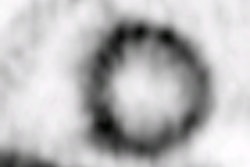
Speaking at the SPIE Medical Imaging conference held February 13-18 in San Diego, Paul Kinahan, Ph.D., a professor of radiology at the University of Washington in Seattle, explained the thinking.
PET/CT scanning has had a tremendous impact on cancer management over the past decade. Within a few years of its introduction, the multimodality approach was dominant, with many studies showing combined PET/CT to be diagnostically superior to either modality alone. "There is considerable evidence that it does make a difference -- the whole is greater than the sum of the parts," Kinahan told attendees at his keynote presentation.
Aside from its huge potential in diagnostic imaging, PET/CT could prove invaluable in helping to develop new treatment techniques. In particular, Kinahan cited lung cancer, which causes more fatalities than any other cancer, as a key target. Unlike breast and prostate cancers, in which the five-year survival rate is improving, five-year survival for lung-cancer patients has not changed. Thus, there's a real need to strengthen existing therapies and develop new ones, he explained.
One of PET's big selling points is its potential for performing quantitative measurements, as each voxel provides a linear measure of tracer concentration. Quantitative measures of individual therapeutic response, for example, could prove invaluable for drug discovery and clinical trials. Other applications include the instigation of image-guided therapies and creation of radiotherapy treatment plans based on biological factors such as hypoxia. "Accurate quantitation has a pivotal role in developing therapy," said Kinahan.
In practice, however, PET imaging is not truly quantitative. While this isn't a limiting factor for diagnostic applications, Kinahan argues that for therapy, "the numbers do matter." There are several pressing needs, for example, determining the bias and variance in multicenter studies. Another factor that's particularly detrimental to quantitative imaging is respiratory motion: both motion during the PET and CT scanning, as well as mismatches between the two.
Compensation strategies
Kinahan and colleagues investigated the impact of respiratory motion on tumor quantification and delineation, in a study of around 1,300 respiratory traces with three different breathing patterns. On average, respiratory motion caused a 28% underestimation of standard uptake values and overestimation of lesion volume by 130%. Clearly there's a case for respiratory motion compensation in PET/CT, he said.
Various methods can be applied to counteract respiratory motion and improve quantitative assessment. Breath-hold PET is available already, and respiratory-gated PET is also well under development. Respiratory gating improves accuracy but can sometimes induce other problems. Because one CT scan is applied for attenuation correction of all phases of the PET data, CT artifacts can dominate true tracer uptake values. In particular, if there is respiratory mismatch between the two modalities, the effects can be quite unpredictable.
The next step could be phase-matched attenuation correction, in which CT scans are taken at each respiratory phase. Kinahan and colleagues have also proposed a method that aligns the PET images to a single phase, reducing blurring artifacts that impact lesion quantification.
This technique, dubbed respiratory-aligned-summed-phases (RASP), works by attenuation correcting each respiratory phase of the PET data with the same phase of the respiratory-gated CT data, and then reconstructing the attenuation corrected PET images. Applying this technique in a patient study resulted in improved resolution without increasing image noise.
An alternative approach, under investigation by a group at GE Global Research in Niskayuna, NY, is RRA (reconstruct, register, average). Here, each gated image is reconstructed independently, followed by registration to a reference gate and averaging to give a motion corrected PET image.
Kinahan concluded that PET/CT offers great potential to help develop new therapies, but that there's a real need to build in respiratory motion compensation. Another challenge is to ensure homogenous calibration between sites when performing multicenter studies. "If we can improve quantitation, molecular imaging biomarkers have a definite role in drug discovery, clinical trials, treatment planning, and therapy."
By Tami Freeman
Medicalphysicsweb editor
April 2, 2010
Related Reading
ROI can influence quantitative FDG-PET study results, September 11, 2007
© IOP Publishing Limited. Republished with permission from medicalphysicsweb, a community Web site covering fundamental research and emerging technologies in medical imaging and radiation therapy.



















